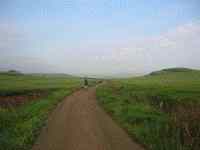 Lush greenery with pilgrims galore (960x720, 32K) |
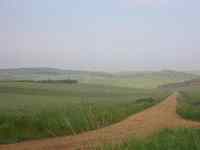 Pathways on the way to Santo Domingo (26K) |
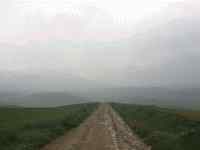 Wildness and wet on the way to Santo Domingo (24K) |
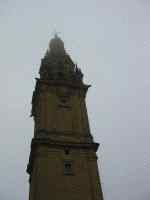 Fog-shrouded Spire & poultry Santo Domingo de la Calzada (22K) |
Camino Day 7 - Mon 3/6/2002:
|
22 km today 221 total |
Arose at 7, had breakfast of coffee and toast provided by Roland, and headed off. Today was going to be a short day: I would stop in Grañón, 22 km further on, and would deliver letters and presents from a guy I know whose father hails from there. I had carried the (thankfully lightweight) presents from Cork for 'Txus (a Basque variant of Jesús, pronounced "Choos"), a friend of mine who worked in Apple. He assured me I'd be treated royally: he was not wrong.
The weather was foggy and hazy, but not actually raining except for short spells, though it had rained a bit during the night which made some of the going a bit mucky. The terrain was generally flat, with the camino gently rising over low hills. There was a fairly constant stream of pilgrims. This, coupled with generally straight camino and a complete lack of trees or cover of any sort, made taking a leak a bit of a problem. My trick was to get as far ahead as possible of people behind me, and at the same time as close as possible to people in front of me, and then whip my camera out and pretend to be taking a picture of some interesting far-distant feature whilst simultaneously taking a leak. All the while hoping the people in front of me don't look back. I probably wasn't fooling anyone, but I wondered what women would do in the same situation (and later found out from the two swiss girls who'd helped me yesterday that if the weather was at all damp, interesting uses could be made of a poncho. Ingenious.)
 Lush greenery with pilgrims galore (960x720, 32K) |
 Pathways on the way to Santo Domingo (26K) |
 Wildness and wet on the way to Santo Domingo (24K) |
 Fog-shrouded Spire & poultry Santo Domingo de la Calzada (22K) |
Arrived in Santo Domingo de la Calzada just before 10 AM: 16km in well under 3 hours. Good going! Those anti-inflammatory pills certainly did the trick on the knees. Now it's just my feet! Alas, the weather was quite foggy, with the cathedral's spire well-nigh invisible. An interesting town, by all accounts. From Raju:
The town takes its name from Santo Domingo (1019-1109). Originally a shepherd, he wanted to enter the monastery of San Millán de Cogilla but was refused because he was illiterate. He then built himself a hermitage and chapel in a notoriously bandit-infested stretch of the camino between Logroño and Burgos and began to look after the needs of pilgrims. He built a hospital (today converted into a Parador) and church in what became the present-day town, a causeway and bridge over the river Oja, and devoted the rest of his life to road and bridge building. One of his disciples, San Juan de Ortega, continued his work.
The town contains several places of interest, but the most well known is the Cathedral, where Santo Domingo is buried. However, what is most likely to strike the visitor are its unusual occupants: a cock and a hen (both very much alive) in a cage high up inside the building, reminders of a miracle. A family of three pilgrims stayed in an inn in the town where the innkeeper's daughter is said to have made advances to the son, who refused the offer. In revenge, she secretly placed a bag of money in his luggage, and the following morning, after they had left, "discovered" that the money had gone missing. The innkeeper pursued the family, the son was brought before the judge, condemned to death, and duly taken to be hanged. The distraught parents continued their pilgrimage to Santiago, and on the return journey spent the night in Santo Domingo de la Calzada once again.
The mother went to the site of her son's hanging, and found him there alive, though still hanging. Accordingly, the parents went to see the judge to ask for their son to be released. Like his counterpart in the apocryphal account of the death of Judas Iscariot, he too was sitting at dinner when the couple arrived, and, likewise, refused to believe them. He declared that the boy was no more likely to be alive than were the cock and hen on his table to get up and fly, which they immediately did, as proof of the son's innocence.
Though Cees Nooteboom's Roads to Santiago has a slightly different version of this legend.
My destination for the day, Grañón, some 6km further on, was originally a walled town with two monasteries, a castle and a pilgrim hospital; little of this is left, but its history seeps through the town. I found the main refugio, which appears to be run by a German religious group with German volunteers. They feed you, provide you with somewhere to bathe and sleep, don't charge anything, and are unique on the camino in being the only refugio that doesn't have an official stamp ("You can get a stamp for your credencial anywhere -- here, we stamp your heart".) Yeeess -- but I certainly wasn't about to cavil. The refugio proper is in a building attached to the very ornate main church in Grañón. I stowed my bags, had a shower, and set about finding Txus's buddies, who it turned out were running a refugio attached to a small chapel, La Ermita de los Carasquedos, about 2km outside of town. A very helpful chap in a bakery showed me the road. Apparently, the Camino used to run through this spot in the not-too-distant past, and there are still rumblings of discontent on the web about this and other naughtiness with the Camino route through Grañón. See, for example, here.
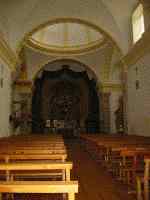 Ermita de los Carasquedos Near Grañón (960x720, 41K) |
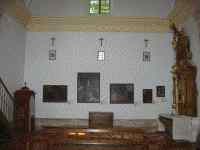 Ermita de los Carasquedos Near Grañón (960x720, 36K) |
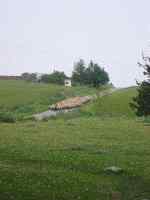 Shepherd & flock Near Grañón (960x720, 44K) |
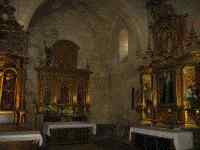 Ornate side altar Main Church, Grañón (960x720, 50K) |
I found Rosanna & Felix, and delivered Txus's presents, to great acclaim and fuss, with much translation by Rosanna. They showed me the lovely old Ermita (or Chapel), whose classical spareness contrasts dramatically with the ornate main church in Grañón, and made me stay to lunch, which was Caparones con los sacramentos: a very hearty bean and blood pudding stew with los sacramentos (or "the works", as I would translate it ;-) - pigs foot and pig's ear, and probably other bits that they were too kind to tell me. Luckily I'd eaten pig's bits before, but nearly everyone I know grimaces when I describe this. It was actually very tasty, and probably contained enough calories to keep a small village going for a couple of weeks. Rosanna made me eat all the pig's feet. It was all washed down by copious quantities of a scrummy local wine. (By way of a footnote, there is a small monument on the way from Santo Domingo de la Calzada to Grañón dedicated by the people of both towns to "Los Bravos". Alas, I have no photo, but I asked Rosanna about it, and she told me the story: years and years before, a small but fertile patch of land near the site was the object of constant warfare between the people of Grañón and those of Santo Domingo. It was decided to settle it with single combat by the champions of both towns - Los Bravos. The man from Santo Domingo was fed a diet of meat, corn and eggs -- this being before the introduction of potatoes to Europe -- whereas the Grañón hero (one Martín de Chavarre, IIRC) was fed on Capparones con los sacramentos. And of course, he won, which assured the lasting notoreity of the dish, at least in Grañón. But today, the peoples of the two towns meet every year at the site of the monument to commemorate the battle.)
Who should arrive while I was having lunch but Txus's grandmother, Asun, for whom I also had carried presents from Txus and whom Rosanna had alerted. A sprightly septuagenerian, she'd walked out the 2km from her home in Grañón. Many more translations and much hugging. I had coffee with her at her house later, and she walked around Grañón with me to show me the Camino. A very friendly lady; as indeed was the shepherd who saw me taking a picture of him leading his flock, came over and had a conversation with me about the World Cup, despite his complete lack of English and my 100-odd words of Spanish. Amazing.
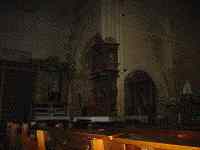 Another side altar Main Church, Grañón (960x720, 34K) |
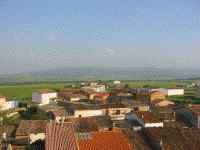 Grañón from the church tower (960x720, 50K) |
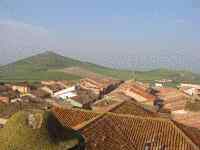 Grañón from the church tower (960x720, 58K) |
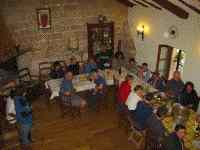 Meal Grañón Refugio (960x720, 49K) |
A mass that night in the main, highly ornate Grañón church was followed by a lovely meal provided gratis by the volunteers running the refugio. (I believe they are connected to a German religious group.) I bumped into the Canadian priest and his buddy again, but since they were under time constraints, they decided to keep going to Recedilla del Camino, 4km further on. In the meal photo, I'm sitting next to Pat, a policeman from Canada, a very entertaining chap who was definitely enjoying his time on the Camino.
I was in complete agreement with him. After the friendliness and fun I had today, what are blisters and sore knees?
|
Prev |
Home |
Next |